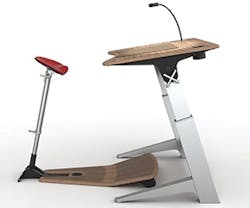The average adult spends 9.3 waking hours per day sitting, according to the British Journal of Sports Medicine.
As the work of humans has shifted from hunting boars to hunching behind computers, productivity has surged but health has slouched.
The so-called sitting epidemic can contribute to actual illness – higher levels of sedentary behavior are linked with a 112% rise in the risk of type 2 diabetes and 147% in cardiovascular disease, according to research conducted in the U.K. by the University of Leicester and Loughborough University.
It can even lead to earlier mortality rates. The American Cancer Society found that men who sat six hours or more per day are 20% more likely to die within 15 years than those who sat three hours or less. For women the figure is 40%.
Don’t sit idly by when it comes to this issue. Take a stand by incorporating the following seating alternatives into your workplace.
1) Perching
“I was not originally aware of the sitting crisis,” says Martin Keen, CEO of Focal Upright Furniture LLC. “I came up with the idea to fulfill a personal need. I didn’t like sitting and didn’t feel creative while motionless in a traditional seat.”
Focal’s Locus Workstation provides users with a posture halfway between standing and sitting, a concept Keen discovered while leaning against his design table.
“I think of it not as a new way of sitting but as a new way of working,” he explains. “It’s more energized.”
The bulk of Focal’s clients have been physical therapists, doctors, and lawyers, but larger corporations have started out with a few to test and come back for more, Keen explains.
“It’s not your grandfather’s office chair. It doesn’t look or function like anything you’ve seen before,” he adds. “But it’s a very familiar posture, like leaning against a couch or picnic table.”
Another style of perching is provided by aeris-Impulsmöbel’s Muvman stool, which provides vertical and lateral motion with a tilted spring center post.
“The concepts are life in motion and the active office,” explains Sandra Bowie, the North American representative for the German manufacturer. “When you incorporate activity into the workday, people tend to concentrate better because they don’t get as tired versus just sitting statically.”
The Muvman is popular in higher education, healthcare, offices, assembly lines, and collaborative environments, Bowie says.
“More workers are Generation Y, and they don’t like being tethered to their dad’s old-fashioned office. They want something different, because technology like smartphones and tablets allow them to work differently,” adds Bowie. PageBreak
2) Standing
“We’re trying to make a difference in the way people have been forced to work for so long,” says Wendy McCubbin, senior wellness manager for Ergotron, manufacturer of several sit-stand workstations. “We had done our due diligence based on ergonomics by making working environments more comfortable and optimal, but we realized that we were part of the sitting problem.”
Ergotron’s WorkFit line can be clamped onto existing work surfaces or is offered as a free-standing, height-adjustable desk.
“It’s important to allow the capability to sit or stand because standing all the time isn’t good either,” says McCubbin. “The benefits of burning calories and increasing blood flow actually come from switching positions.”
Becoming part of the solution is in the best interest of business, McCubbin adds.
“If companies are designing an environment based on a cookie cutter approach, they could actually be putting their own bottom line at risk,” she explains. “People are either at their desk and not focused because they’re in pain, or they’re out of the office attending to their diseases or discomfort.”
There are also direct costs in addition to productivity problems, McCubbin adds. Some ailments impact healthcare premiums, and with biometrics being incorporated into more company health plans, employee health should be a top concern. For every $1 invested in wellness, companies save $3-6, according to the U.S. Centers for Disease Control and Prevention.
“Providing sit-stand workspaces can not only achieve happier, healthier, more productive employees, but also minimize the costs associated with the dangers of sitting,” explains McCubbin.
3) Moving
Although a more sizable investment, treadmill and stationary bike desks could arguably provide the most benefits.
“These products allow you to remain productive while integrating movement with normally sedentary tasks,” explains Peter Schenk, president of LifeSpan, an equipment manufacturer. “The treadmill desk isn’t an alternative to exercising. It’s an alternative to sitting.”
For this reason, the treadmill doesn’t go above 4 mph and its whisper-level operation makes it ideal for use in workplaces. It also offers armrests for ease of typing or writing while exercising.
Most businesses enhance occupant health by improving indoor air quality and limiting life safety issues. But it may be time to focus on physical condition as well.
“The average American burns 100 fewer calories each day than they did a few decades ago and we’re trying to change that,” Stanco adds.
Chris Curtland [email protected] is assistant editor of BUILDINGS.
